However, overlooked until a small portion found its way across "The Pond" to the United States in 1961, as a "Summer Television Replacement", was a British series that initially ran from September 11, 1960 through January 20, 1962 in the United Kingdom. The program was about another "Secret Agent" who predated James Bond on the motion picture screen, but not the television. Unlike the movie's gadget filed Bond who always got the girls. This television character was realistic in the "Cold War" settings of the shows episodes and would become a cult classic. He was John Drake and was played by actor Patrick McGoohan.
This article is a look at my three favorite television roles, starting with Drake, that the actor portrayed.
A Biographical Sketch
What might surprise many of his fans in the United States is that Patrick Joseph McGoohan was born here on March 19, 1928 is Astoria, New York. However, his parents Thomas and Rose Fitzpatrick McGoohan returned to their native Ireland shortly after their son was born, Patrick would have dual citizenship. Seven years after returning to Ireland the family moved to Sheffield in South Yorkshire, England. The boy would attend school there until World War 2 came to Great Britain.
Like many British youths when the "Blitz" began. The young boy was sent away from London and would continue his education at Ratcliffe College. Ratcliffe was a co-education Catholic school located in Leicester in the East Midlands.

In 1944 Patrick left school, at the age of 16, and returned to Sheffield. Prior to becoming the stage manager of the "Sheffield Repertory Theatre". The young man was a chicken farmer, a bank clerk and a lorry driver. When one of the actors became ill Patrick McGoohan was asked to play the roll and his acting career began.
One memorable performance and comment about the early work of Patrick McGoohan is proper at this point, before I discuss those three roles I have enjoyed over and over again.
On June 16, 1955 Orson Wells premiered a play at "The Duke of York's Theatre" in London called "Moby Dick-Rehearsed". Wells had of course written the play, was directing the play and acted in his play. Patrick McGoohan was cast as "Starbuck". Others in the cast were Christopher Lee, Kenneth Williams, who would become a regular cast member in 26 of the internationally successful British "Carry On" comedy features. Along with Gordon Jackson seen in the United States in "The Great Escape" and "Upstairs, Downstairs" among other films and actress Joan Plowright the future Baroness, Dame and wife of Sir Laurence Olivier.
According to the 1992 Orson Wells autobiography "This Is Orson Wells" co-written with Peter Bogdanovich. Wells in 1969 told an interviewer the following about Patrick McGoohan. This was based upon what he thought of the actor, at the time, during that 1955 performance. According to Orson Wells, McGooghan::
would now be, I think, one of the big actors of our generation if TV hadn't grabbed him. He can still make it. He was tremendous as Starbuck.Below is a picture of the actor prior to his marriage in 1951 with his future life long partner Joan Drummond.

DANGER MAN
Every government has its secret service branch. America, CIA; France, Deuxième Bureau; England, MI5. NATO also has its own. A messy job? Well that's when they usually call on me or someone like me. Oh yes, my name is Drake, John Drake.
Back on October 24, 1954 on the American television anthology program "Climax". Actor Barry Nelson portrayed CIA Agent Jimmy Bond, Australian actor Michael Pate portrayed MI-6 Agent Clarence Leiter and Peter Lorre was the first "James Bond" villain Le Chiffre. Name changes and all this was Ian Fleming's "Casino Royale" on live television. Look at the video of the broadcast on DVD/BluRay and you can even spot the "Boom Mike's" shadow in scenes that only "Live" television could bring you.
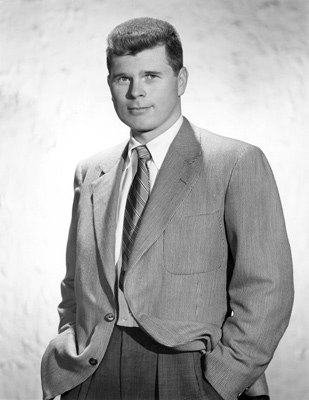
Above Barry Nelson as Jimmy Bond
Below Michael Pate as Clarence Leiter

Below Peter Lorre as the first James Bond villain for the trivia buffs out there
British motion picture screenplay writer and television producer Ralph Foster Smart wanted to bring Ian Fleming's "James Bond" back to the United Kingdom television sets were it belonged. He had been aware of the American adaption of "Casino Royale" and wanted to correct that impression. Smart met with the author over adapting his novels and character's into a television series. At some point in the development Fleming dropped out and Ian Stuart Black entered..
Black was a novelist, screenplay writer and playwright. It was his input that changed the leading character from the look of Fleming's "Double O Seven" to a "Lone Wolf" named John Drake. In the future Black would write episodes of "Dr. Who" featuring the first and second Doctor's William Hartnell and Patrick Troughton. His other works included a television series based upon H.G. Wells "The Invisible Man". The story was brought to the present and the title character became involved in stopping foreign espionage. The show was reminiscent of Universal Studios 1942 "Invisible Agent" that had the title character fighting the Nazis. A classic piece of British television science fiction written by Black was "Star Maidens". On "Danger Man" Ian Stuart Black would also become an Associate Producer.
"Danger Man" was in actuality two series. The first contained 39 episodes running between 24 to 25 minutes.
When the British audience for the "Incorporated Television Company (ICT)" program first met Patrick McGoohan as John Drake. Drake worked in Washington D.C. for an special operations agency somehow connected with the "North American Treaty Organization (NATO)". His assignments often took him to Africa, Latin America and Asia fighting for democracy.
In Episode Nine we learn that John Drake was born in the United States of Irish parents a reflection of the actor portraying the character.
The following still is from the first season of "Danger Man". The episode is "Bury the Dead" which premiered March 19, 1961. In the first picture NATO operative John Drake is speaking to Jo Harris played by American actress Beverly Garland. Harris is the fiancée of a fellow agent Drake believes was murdered while investigating smugglers in Latin America . The cast also included Patrick Troughton, and Robert Shaw.
Several websites state that in April of 1961 the "Columbia Broadcasting System (CBS)" brought the first version of John Drake to the United States as a summer replacement. According to these websites "Danger Man" would replace Steve McQueen's Josh Randall of "Wanted Dead, or Alive" while the program was on hiatus. However, McQueen's show's final episode had aired on March 29th. What is fact is that only 24 of the 39 episodes of the original "Danger Man" program were shown in the United States during that summer. These were presented under the "Danger Man" title and not "Secret Agent" which was to come.The following year saw the actual International Release of the original 39 episodes,
By the time of the International Release of "Danger Man". Sean Connery had said the line I started my article with and James Bond was being seen around the world and copied..It should be noted at this point that Patrick McGoohan was first offered the part of Bond for "Dr. No", but turned it down stating:
I thought there was too much emphasis on sex and violence,
It has an insidious and powerful influence on children. Would you like your son to grow up like James Bond? Since I hold these views strongly as an individual and parent I didn’t see how I could contribute to the very things to which I objected.”These quotes and more of the story can be found on the website for the British "Express" dated April 29, 2011 at:
http://www.express.co.uk/expressyourself/243597/A-prisoner-of-his-demons
At this time on United Kingdom television sets there was another spy series created by "Associated British Corporation" called "The Avengers". Although this program premiered 22 months prior to the motion picture "Dr. No". After the pictures release it too started having fun with the Bond image of secret agents. In the United States the "American Broadcasting Company (ABC)" would run seasons 4 and 5 of "The Avengers" starting three years later.
What had been unexpected by Smart and McGoohan was the world wide interest in the character of John Drake. In many countries "Danger Man" was being compared to Harry Saltzman and Albert R, Broccoli's on screen image of Ian Fleming's James Bond. As a result the Smart and McGoohan made a decision to bring back the character. Between the end of the first version of John Drake and the emergence of the second version. Patrick McGoohan had been working on other projects including a television three part mini-series for Walt Disney that I will discuss shortly.
Danger Man aka: Secret Agent aka: Destination Danger aka: John
Drake
The new "Danger Man" episodes had a running time of 48 to 49 minutes in length and except for the last two that were filmed in color. The other 45 episodes were in black and white. Episode 39, the last episode of the first series, premiered in the United Kingdom on January 20, 1962. While the first episode of what was called "Series Two" did not premier on British television sets until October 13, 1964 two years and ten months later.In his previous incarnation John Drake had an American ascent and the implication was he was born and lived in the United States. In the new series his accent became very British as did his nationality. John Drake was no longer an American of Irish parentage, but a man born and raised in England. Also Drake's employer had changed. He no longer worked through NATO, but was an agent for a "Secret British Intelligence Service" referred too as "M9". Which like John Steed of "The Avengers" seemed to be MI-6 without the Military involvement as seen in the Bond motion pictures.
Speaking of Patick Macnee's John Steed. Steed always worked with a lovely female partner. Originally in 1961 his partner was Ingrid Hafner as Nurse Carol Wilson for the first season, but it was cut short by a strike. When the series resumed filming Hafner had left. So in 1962 Steed returned with Julie Stevens portraying Nightclub singer "Venus Smith".. During that second season Stevens was joined by Honor Blackman as widow Cathy Gale. Three major changes to the third season occurred when the first episode premiered on September 28, 1963. The character of "Venus Smith" was out. The style of the show reflected more of the Bond influence. Honor Blackman's Cathy Gale had become the equal of Mcnee's Steed and some of the episodes implied an intimate relationship between the two.

Honor Blackman would leave "The Avengers" supposedly due to conflicting filming dates to make the James Bond picture "Goldfinger". Cathy Gale would be replaced by the most widely known partner for John Steed. This was actress Diana Rigg as Mrs. Emma Peel starting with the fourth season. We still can't escape the influence of Ian Fleming's James Bond as Rigg would leave "The Avengers" to play "Tracy" in "On Her Majesty's Secret Service". After Rigg left the series Linda Thorson became Tara King.
So what has this to do with Patrick McGoohan as John Drake?
Although the world wide motion picture and television audiences for secret agents and spy's had become accustom to seeing the hero with seductive women, or an overly beautiful lady in distress. In the entire 86 episodes of "Danger Man" John Drake had no real romantic ties, or one night stands. Although he is heard complimenting some of his female co-workers. The one real exception to this came in the episode "Are You Going to Be More Permanent". Where it appears that there could have been more to Drake's feeling toward Lesley Arden portrayed by actress Susan Hampshire, but still nothing on screen ever came form it.
In the excellent "The Danger Man Website" is the following description of the two characters:
At the conclusion of the episode, it is refreshing that it is Drake’s charm that wins the day, a resolution underpinned by subtle, bittersweet performances from McGoohan and Hampshire.
http://danger-man.co.uk/episodeDetails.asp?episodeID=71&seriesNo=2
Below Susan Hampshire and Patrick McGoohan .
I should note that in the episode "The Black Book". John Drake "almost", as "The Danger Man Website" uses, falls for the female lead character of Simone portrayed by Georgina Ward, but comes to his senses about her. See the picture below:
The female characters of Drake's world are mainly presented as professional agents for M9, or as with Beverly Garland, mentioned above, part of the story but not a romantic interest to the hard edged Patrick McGoohan. All this is in keeping with the realism goal of the series set by the actor and Ralph Smart. Plus the fact, mentioned above, that McGoohan publicly denounced the sexual promiscuously of the Bond films and another British television series "The Saint" starring Roger Moore as Simon Templar.
This put "Danger Man" in sharp contrast with other television programs seen at the time in the United States. Such as "Honey West", "The Wild, Wild West" and "The Man from Uncle". Along with motion picture spy films with characters such as "Matt Helm" played by Dean Martin in "The Silencers", or the fantasy world of James Corburn's "Derek Flint" in the film "Our Man Flint". However, you could find an occasional exception to the influence of James Bond in such movies as "The Ipcress FIle" starring Michael Caine, or Richard Burton in "The Spy Who Came in from the Cold"
While the British motion picture "Modesty Blaise" spoofed the James Bond craze. The film rights to Ian Fleming's "Casino Royale" were owned by Columbia Studios. They turned the serious spy novel into a major comedy with seven actors being called "James Bond" and Woody Allen playing "Little Jimmy Bond" the villain.
Through all this was Patrick McGoohan as John Drake "Danger Man" gathering a large audience and a cult following for the seemingly realistic situations of his show compared to everything else out there.


In 1965 CBS television started broadcasting the new version of John Drake from "Series Two" of "Danger Man". The title had been changed to attract audiences in the United States to "Secret Agent".
Then there was that song "Secret Agent Man" composed by P.F. Sloan and Steve Barn and sung by Johnny Rivers.
There's a man who leads a life of danger
To everyone he meets he stays a stranger
With every move he makes another chance he takes
Odds are he won't live to see tomorrow
Secret agent man, secret agent man
They've given you a number, I know they've taken away your name
Secret agent man, secret agent man
They given you a number, oh they've taken away your name
Beware of pretty faces thay you find
A pretty face can hide an evil mind
Ah, becareful what you say
Or you'll give yourself away
Odds are you won't live to see tomorrow
Secret agent man, secret agent man
They've given you a number, I know they've take away your name
Secret agent man, secret agent man
They given you a number, oh they've taken away your name
Swingin' on the Riviera one day
And then layin' in the Bombay alley next day
Oh, don't you let the wrong word slip
While kissing persuasive lips
Odd are you won't live to see tomorrow
Secret agent man, secret agent man
They've given you a number, oh they've taken away your name
Secret agent man, Secret agent man
Everywhere you went at the time the song came out. You would find people either whistling the tune, or attempting to sing the lyrics. I know, because I was one of them.
The "Danger Man" Motion Picture and the End of the Series
The two episodes in question are "Koroshi" and "Shinda Shima" and were combined into the only "Danger Man" feature film for the European movie market just called "Koroshi". It would show up eventually on American television.
Some of the Danger Man Merchandise and a Mouse
Music
Comic Books
Below the first issue of the British comic book
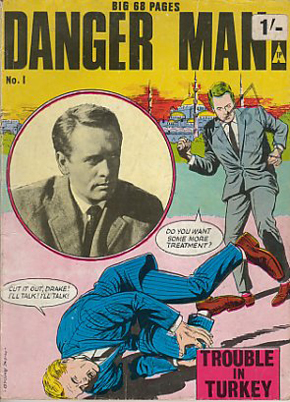
Below the American comic book for the original "Summer Replacement" series.

Below the cover of a French "Destination Danger" comic book.
Below one of the American comic books for "Secret Agent"
Jigsaw Puzzles

British Bubble Gum Cards
The Danger Mouse Cartoon Series
The British cartoon series originally ran from September 28, 1981 through March 19, 1992 with 161 episodes. The show was a parody of British spy fiction and specially the obvious "Danger Man" television series and the "James Bond" motion pictures.
Here are some still from that original series.

In 2015 the series was revived with another 50 episodes running from September 28, 2015 through October 20, 2016. The look of the characters was updated somewhat.
DR. SYN ALIAS THE SCARECROW
In 1915 author Russell Thorndike wrote his novel "Doctor Syn: A smuggler tale of the Romney Marsh". This book is still a very fun read about pirates and smugglers under England's King George.
The novel was originally planned as a single story, but in 1935 Thorndike decided to tell the complete history of feared and unsympathetic Pirate Captain Clegg. Who became the kindly Vicar of Dymchurch, England, Dr. Christopher Syn and the secret leader of a group of smugglers.
As I did attempting to read the E-book versions of all seven works. My reader would get confused by the original publication dates of the other novels. Here is the correct chronological reading order for those, who like myself, like a good tale to read. You will note that the 1915 novel now becomes the last in the series of seven..
1. Doctor Syn on the High Seas
2. Doctor Syn Returns
3. The Further Adventures of Doctor Syn (Not in "Complete Collections" as not published until 1966)
4. The Courageous Exploits of Doctor Syn
5. The Amazing Quest of Doctor Syn
6. The Shadow of Doctor Syn
7. Doctor Syn: A Tale of the Romney Marsh aka: Doctor Syn: a smuggler tale of the Romney Marsh
Although Dr. Syn was known as "The Scarecrow" in Thorndike's novels. Many of the real life smugglers of the Romney Marsh were called "Owls", because of the sound of the signals they made to each other.
Before I can talk about the Walt Disney mini-series about Dr. Syn starring Patrick McGoohan, or the other filmed versions. I need to give my readers a look at the Romney Marsh and it's relationship to Dymchurch.
'
The following are photos of today's Romney Marsh and if my reader lets their imagination loose. You can see the smugglers receiving their goods from France and being chased across the marsh lands by the British Revenue Agents.
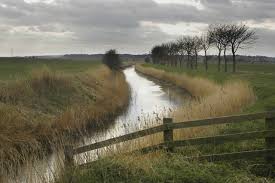

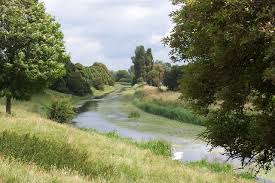
On the above map's middle right. My reader will find the location for Russell Thorndike's tales of Dr. Syn the town of Dymchurch. To the town's immediate left are the 100 square acres of the Romney Marsh. The town of Dymchurch was actually created during the gradual build up of the marsh area and the communities surrounding it. Dymchurch was known to be directly associated with smugglers in the 17th and 18th centuries. On the opposite side of the town is the English coast line known as "The White Cliffs of Dover". It was here that illegal French ships met with real smugglers and brought wine and other goods into England to avoid the steep import taxes of King George. The same King George that the then American colonies fought for their independence.
Although Dr. Syn was known as "The Scarecrow" in Thorndike's novels. Many of the real life smugglers of the Romney Marsh were called "Owls", because of the sound of the signals they made to each other.
Christopher Syn first came to the big screen in 1937 in the Gainsborough Pictures presentation "Doctor Syn" starring George Arliss.
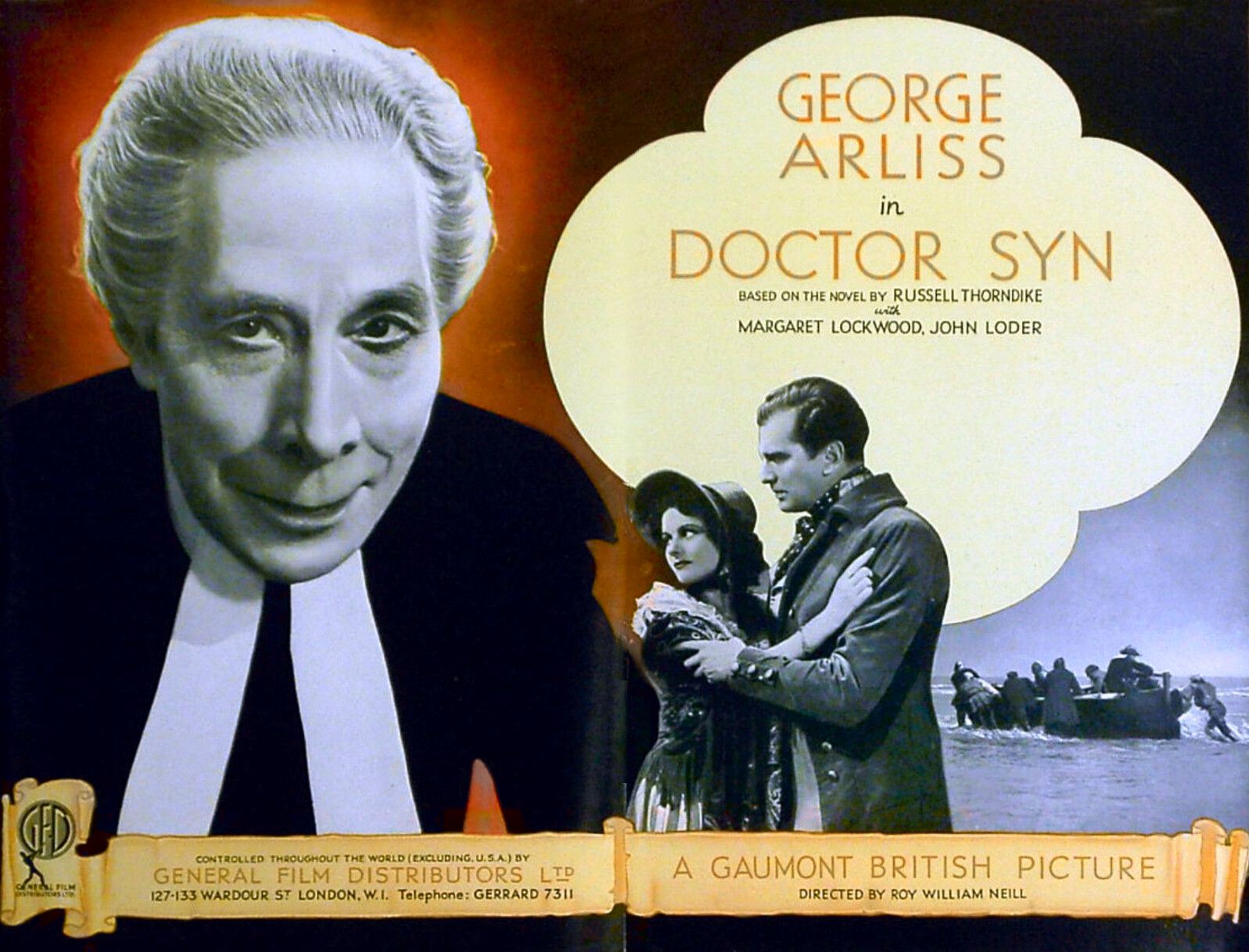
In the novels the Mulatto, shown in the 1937 motion picture, has had his tongue cut out, his ears partly cut off by Captain Clegg and left to die. However, he is saved and starts to work for the British Revenue Agents tracking down smugglers and the truth about Dr. Syn.

In 1962 Hammer Films made the second motion picture based upon Thorndike's novels. In the United Kingdom the picture starring Peter Cushing was titled: "Captain Clegg". When it was released in the United States, because of Hammer's "Horror" reputation here. The movie's title was changed to "Night Creatures".

Note the misleading tag line and the accompanying picture used for the United States title. It gives the impression to the potential American viewer that this was a horror film like others, such as "The Curse of Frankenstein" and "The Curse of the Werewolf", previously released by the House of Hammer in the United States. The same implied horror was used to promote Sir Arthur Conan Doyle's Sherlock Holmes story "The Hound of the Baskervilles" in 1959 from Hammer.
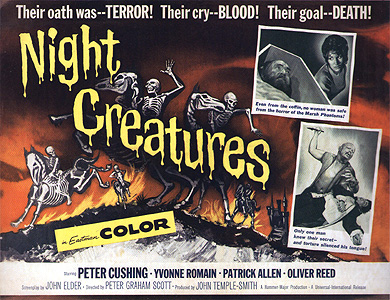
Hammer's film seemed to relay on "All Hallows Eve" costumes for "Dr. Bliss", for some reason not Syn, and his men and the source of the skeleton riders seen in the above poster.
On the above map's middle right. My reader will find the location for Russell Thorndike's tales of Dr. Syn the town of Dymchurch. To the town's immediate left are the 100 square acres of the Romney Marsh. The town of Dymchurch was actually created during the gradual build up of the marsh area and the communities surrounding it. Dymchurch was known to be directly associated with smugglers in the 17th and 18th centuries. On the opposite side of the town is the English coast line known as "The White Cliffs of Dover". It was here that illegal French ships met with real smugglers and brought wine and other goods into England to avoid the steep import taxes of King George. The same King George that the then American colonies fought for their independence.
Although Dr. Syn was known as "The Scarecrow" in Thorndike's novels. Many of the real life smugglers of the Romney Marsh were called "Owls", because of the sound of the signals they made to each other.
Christopher Syn first came to the big screen in 1937 in the Gainsborough Pictures presentation "Doctor Syn" starring George Arliss.

In the novels the Mulatto, shown in the 1937 motion picture, has had his tongue cut out, his ears partly cut off by Captain Clegg and left to die. However, he is saved and starts to work for the British Revenue Agents tracking down smugglers and the truth about Dr. Syn.

In 1962 Hammer Films made the second motion picture based upon Thorndike's novels. In the United Kingdom the picture starring Peter Cushing was titled: "Captain Clegg". When it was released in the United States, because of Hammer's "Horror" reputation here. The movie's title was changed to "Night Creatures".

Note the misleading tag line and the accompanying picture used for the United States title. It gives the impression to the potential American viewer that this was a horror film like others, such as "The Curse of Frankenstein" and "The Curse of the Werewolf", previously released by the House of Hammer in the United States. The same implied horror was used to promote Sir Arthur Conan Doyle's Sherlock Holmes story "The Hound of the Baskervilles" in 1959 from Hammer.

Hammer's film seemed to relay on "All Hallows Eve" costumes for "Dr. Bliss", for some reason not Syn, and his men and the source of the skeleton riders seen in the above poster.
Below Peter Cushing as the kindly Dr. Christopher Syn

Both of these previous filmed versions were based on incidents in Russell Thorndike's original novels and differ from Walt Disney's as a result.
Walt Disney's complete version of the Christopher Syn tale was originally seen in 1964 on his "The Wonderful World of Color" television series. It was an immediate hit. Forty-four years later on November 11, 2008 the Walt Disney Company released both the original television three part mini-series with Walt's commentary and the shorter 98 minute British (European) feature, released at the end of 1963, on a two DVD disk set with extras. This release was under the "Walt Disney Treasures" label. All 39,500 copies sold out almost immediately. In 2009 for the "Walt Disney Film Club" a special edition of the two disk set was released at $29.95 and sold out almost upon release also.
Today my reader can find, on line, petitions to be completed asking the Disney Company to re-release the original two DVD set. My reader might ask: Why not see if the set is available on line? Actually it is, but it now sells from a low of $179 to as much as $402 depending on the condition. The British feature version on a Disney VHS tape is selling from between $199 to $299. That movie was originally released in the United Kingdom on a double bill with the animated "The Sword in the Stone".
Yes, if you won't worry about copy right laws. You can find DVD-R copies of the "Walt Disney Treasures" two DVD disk release, if you want to take a chance in that direction and on the quality of the recording. Also on line for as little as $12.99 is a title called "Walt Disney's Dr Syn Alias the Scarecrow". However, comments by people buying this item say it is a rip off, poor quality, copy of one of the original cuts.
In the 1970's the "Walt Disney Company" did two different re-edits with that original three part mini-series. The first re-edit became a different feature length film than the original British edit. This new feature version was release either on a double bill with the re-issue of "Snow White and the Seven Dwarfs", or "Treasure Island". The second re-edit of the mini-series ran on the Walt Disney television program in two parts. The middle segment of the original three part series was just dropped.
So what did this three part Walt Disney mini-series look like? A program that 53 years after the first part premiered on Sunday, February 9, 1964 is still creating petitions to the Disney Company for the re-release of the two DVD set.
To begin with as Walt Disney's introduction to that first part of the mini-series explained. His story was not based upon the original seven Thorndike novels. Although websites including"

http://disney.wikia.com/wiki/The_Scarecrow_of_Romney_Marsh
Claim the mini-series
As I mentioned above "The Further Adventures of Dr. Syn" was not published until 1966 three years AFTER Walt Disney released the British feature version and two years after "The Wonderful World of Color" three part series was first shown.

On NBC that first Sunday night during Walt Disney's introduction to the mini-series. He showed his viewers a 1960 novel about Dr. Syn. Also written by British author Russell Thorndike, but co-authored by American author William Buchanan and was called "Christopher Syn". Should you want a copy of that novel with it's introduction by actor James Mason. The book is selling for $350, because of its rarity compared to the first seven novels and is not currently available as an E-Book.

Three major changes to the original novels used for the first two motion pictures are found in this work.
1. There is no Captain Clegg the Pirate. This eliminates the need of the "Mulatto" character seeking revenge against Dr. Syn, or establishing an evil background for the Vicar of Dymchuch.
2.The character of the barmaid Imogene is removed. Imogene and the community of Dymchurch in Russell Thorndike's series of earlier novels have no idea that in reality she is Dr. Syn's daughter born while he was still Captain Clegg. Instead of Imogene we now have the daughter of the Squire of Dymchurch Katherine Banks.
3. The Squire has his name changed from Squire Anthony Cobtree to Squire Thomas Banks. The Squire now has two sons Harry and John, not one, and a daughter Katherine. The romance between Imogene and the Squire's oldest son is now between Katherine and a British officer Lt. Philip Brackenbury.
In short this reworked story of the Vicar of Dymchurch, England, provided the perfect vehicle for the family orientated Walt Disney. Although in his original introduction he mistakenly called Christopher Syn an actual historical figure that the novel was based upon. There never was such a person, but there was the 'Hawkhurst Gang" who did use the "Owl" signal I previously mentioned and is considered to be the basis for Thorndike's original novel. They were definitely not the Robin Hood like character Walt Disney created. Here is a link to an article about them:
http://www.geriwalton.com/hawkhurst-smuggling-gang/
The mini-series opens with a theme song for "The Scarecrow of Romney Marsh" written by Terry Gilkyson. Just as Walt Disney had done for his "Davy Crockett" and "Swamp Fox" mini-series and of course his television series "Zorro". There had to be a catchy song to also record and release:
Scarecrow!
Scarecrow!
The soldiers of the King feared his name
Scarecrow
On the Southern coast of England
There's a legend people tell
Of day's long ago
When the great Scarecrow
Would ride from the jaws of hell
And laugh (Ahahahahaha)
With a fiendish yell!
With his clothes all torn and tattered
Through the black of night he'd ride
From the marsh to the coast
Like a demon ghost
He'd show his face then hide
And he laugh (Ahahahahaha)
"Til he split his side!
So the King told all his soldiers
"Hang him high, or hang him low!
But never return
"Till the day I learn
He's gone in flames below--
Or you'll hang
With the great Scarecrow!"
Scarecrow (Scarecrow)
Scarecrow (Scarecrow)
The soldiers of the King feared his name
Scarecrow (Scarecrow)
Scarecrow (Scarecrow)
The country folk all loved him just the same
Scarecrow!
He would always help the farmer
When there was no gold to bring
He'd find a way
For the poor to pay
The taxes of the King
"Scarecrow"
Ev'ry man would sing!
Scarecrow (Scarecrow)
Scarecrow (Scarecrow)
The soldiers of the King feared his name
Scarecrow (Scarecrow)
Scarecrow (Scarecrow)
The country folk all loved him just the same
Scarecrow!
Scarecrow!
Scarecrow!
(Ahahahahaha)
The first episode opens with "The Scarecrow", his two right hand men "Hellspite" and "The Curlew" being chased by the King's soldiers. They escape into a barn and when the soldiers enter the three are nowhere to be seen. After searching the barn the soldiers leave. The three smugglers are actually in a secret floor beneath the barn's main one.
We next see "The Curlew" remove his mask to reveal the Squire's youngest son John.

We see "Hellspite" remove his mask to reveal the Vicar's Sexton Mipps. In the original novels Mipps was first mate to Captain Clegg.

Next we see "The Scarecrow" unmask and the audience is looking at Patrick McGoohan. It will be the next sequence when we learn he is Dr/ Syn the Vicar of Dymchurch.
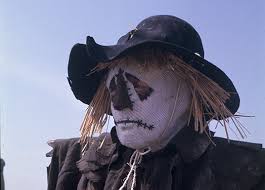

What Dr. Syn's background was prior to arriving in Dymchurch is never made clear. It appears in this version he is just the Vicar and has found a way, by smuggling, to help his parishioners pay their taxes, feed their families and keep their land. The Squire has no idea that Syn and "The Scarecrow" are one and the same, or does he realize his young son John is one of only two people who knows the smuggler's secret identity.
In the article: "From the Jaws of Hell: The Scarecrow of Romney Marsh" on the website "D23" is the following quote about the creation of the mask for Patrick McGoohan from an ordinary dishcloth by make-up artist Harry Frampton:
The complete article can be found at:
https://d23.com/the-scarecrow-of-romney-marsh/
Below the Squire and the Vicar discuss the arrival of General Paugh and his men to find and stop the smugglers and hang their leader "The Scarecrow".
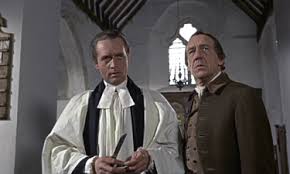
The Squire disagrees with General Paugh's methods, but to a degree as the Head Magistrate for Dymchurch he must comply.

The Squire's daughter Karen has fallen in love with Lt. Brackenbury, but her father strongly disapproves and that is causing friction between the two.
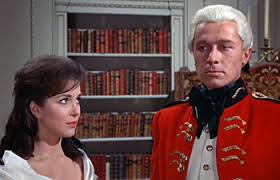
The plot is very Disney as Dr Syn must deal with protecting his flock from the Navy Press Gang. They have arrived to take all able body men away from Dymchurch under orders of General Paugh.


Dr Syn turns the tables on the Press Gang after his Sexton Mipps disguises himself as a cripple who hates the "Scarecrow".They set up a trap to rescue a married man that the Press Gang has taken. When he walked into the bar the Navy men were at looking for the midwife for his wife in labor.

As a result of Dr. Syn's trap the Press Gang is captured, the husband rescued and the sailors delivered to General Paugh in wooden kegs he believed were full of French wine.
Dr Syn discovers that one of his men plans to steal some of the smuggled wines and other goods. Then he is going to leave Dymuchurch, because General Paugh wants him to reveal the names of the other smugglers. Syn sets up another trap for this man as part of a larger plan to eventually make him an example to "The Scarecrow's" men and at the same time get rid of the King's Prosecutor who has come to the town.

The Vicar has John mention to his sister and Lt. Brackenbury that he overheard talk about a smuggling operation and that some of the goods will be taken to the house of the man he wants to make an example. Brackenbury takes a small troop and they capture the smuggler and his sons with a wagon full of goods and as Dr Syn knew the man will be tried by the Squire not the military.
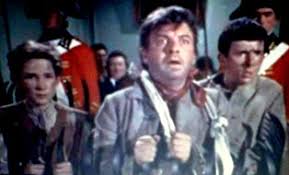
In court Dr. Syn defends the man by asking the simple question has anyone looked into the kegs of alleged French Wine? The kegs turn out to be filled with water and the man and his sons are released.

Then the Vicar calls all "The Scarecrow's" men together and holds court on the smuggler himself in the presence of the King's Prosecutor. Who he has kidnapped. "The Scarecrow's" verdict is death by hanging.


The prosecutor is frightened by the action of "The Scarecrow" and flees Dymchurch as Dr. Syn planned he would. After his own men leave the site of the hanging. "The Curlew" and "Hellspite" take the man down from the make shift gallows. It is all a ruse and the man was never really hung, but fainted again as Dr. Syn planned. The man is told to leave Dymchurch and never return, or "The Scarecrow" will actually kill him.
A fake grave is placed in the church's graveyard stating the man died from natural causes.
In another adventure the Vicar helps an American being pursued by the British soldiers for treason against King George.

This leads to assisting an escaped prisoner from the Navy also. The escapee is also the oldest son of the Squire named Harry whom he hasn't seen for years.
The two men are captured by the British and imprisoned, but with the help of Lt. Brackenbury a rescue is put together right under the eyes of General Paugh. This leads to "Hellspite" kidnapping the Squire and his daughter as a means of both getting them to see Harry leave safely from England out of reach of General Paugh and to keep Dr. Syn's secret identity in place.
There are other adventures in the original three part series and Patrick McGoohan was just perfect as the kindly Dr. Syn. Who eventually convinces the Squire to permit the marriage of his daughter to the Lieutenant. Who has decided to leave the army after revealing to King George and the Army Inspector General some of the faults and tactics of General Paugh.
One piece of trivia concerns something Walt Disney could not have expected to happen. It took place that first Sunday Part One of the series premiered. Opposite NBC's "The Wonderful World of Color" on CBS, at the same time, was the variety show hosted by Ed Sullivan. Sullivan's guest stars that night included the first American television appearance of a group of four young men from Liverpool, England, called "The Beatles". Disney's audience share was way down.
Of course there was the merchandising aspect to any Walt Disney television production. Above I had shown a picture of the recording of the theme song> Here is the cover for that record and note it's price.

I also mentioned the different video releases of the series for sale, but also at the time there were still many people who had 8 mm home motion picture projectors. So naturally Walt Disney released a short version in that format.
Then there was "The Wonderful World of Color" novelization of the mini-series as compared to the Russell Thorndike novels and the one Walt used to base his show.

Currently this book sells on line from between $1.72 to $42.00 depending upon it's condition.
Comic books were a Disney staple.


As I mentioned when speaking of "Danger Man". Patrick McGoohan had plans of his own for another television series.
Both of these previous filmed versions were based on incidents in Russell Thorndike's original novels and differ from Walt Disney's as a result.
Walt Disney's complete version of the Christopher Syn tale was originally seen in 1964 on his "The Wonderful World of Color" television series. It was an immediate hit. Forty-four years later on November 11, 2008 the Walt Disney Company released both the original television three part mini-series with Walt's commentary and the shorter 98 minute British (European) feature, released at the end of 1963, on a two DVD disk set with extras. This release was under the "Walt Disney Treasures" label. All 39,500 copies sold out almost immediately. In 2009 for the "Walt Disney Film Club" a special edition of the two disk set was released at $29.95 and sold out almost upon release also.
Today my reader can find, on line, petitions to be completed asking the Disney Company to re-release the original two DVD set. My reader might ask: Why not see if the set is available on line? Actually it is, but it now sells from a low of $179 to as much as $402 depending on the condition. The British feature version on a Disney VHS tape is selling from between $199 to $299. That movie was originally released in the United Kingdom on a double bill with the animated "The Sword in the Stone".
Yes, if you won't worry about copy right laws. You can find DVD-R copies of the "Walt Disney Treasures" two DVD disk release, if you want to take a chance in that direction and on the quality of the recording. Also on line for as little as $12.99 is a title called "Walt Disney's Dr Syn Alias the Scarecrow". However, comments by people buying this item say it is a rip off, poor quality, copy of one of the original cuts.
In the 1970's the "Walt Disney Company" did two different re-edits with that original three part mini-series. The first re-edit became a different feature length film than the original British edit. This new feature version was release either on a double bill with the re-issue of "Snow White and the Seven Dwarfs", or "Treasure Island". The second re-edit of the mini-series ran on the Walt Disney television program in two parts. The middle segment of the original three part series was just dropped.
So what did this three part Walt Disney mini-series look like? A program that 53 years after the first part premiered on Sunday, February 9, 1964 is still creating petitions to the Disney Company for the re-release of the two DVD set.
To begin with as Walt Disney's introduction to that first part of the mini-series explained. His story was not based upon the original seven Thorndike novels. Although websites including"

http://disney.wikia.com/wiki/The_Scarecrow_of_Romney_Marsh
Claim the mini-series
generally followed the storyline of The Further Adventures of Dr. SynThey are all incorrect.
As I mentioned above "The Further Adventures of Dr. Syn" was not published until 1966 three years AFTER Walt Disney released the British feature version and two years after "The Wonderful World of Color" three part series was first shown.
On NBC that first Sunday night during Walt Disney's introduction to the mini-series. He showed his viewers a 1960 novel about Dr. Syn. Also written by British author Russell Thorndike, but co-authored by American author William Buchanan and was called "Christopher Syn". Should you want a copy of that novel with it's introduction by actor James Mason. The book is selling for $350, because of its rarity compared to the first seven novels and is not currently available as an E-Book.

Three major changes to the original novels used for the first two motion pictures are found in this work.
1. There is no Captain Clegg the Pirate. This eliminates the need of the "Mulatto" character seeking revenge against Dr. Syn, or establishing an evil background for the Vicar of Dymchuch.
2.The character of the barmaid Imogene is removed. Imogene and the community of Dymchurch in Russell Thorndike's series of earlier novels have no idea that in reality she is Dr. Syn's daughter born while he was still Captain Clegg. Instead of Imogene we now have the daughter of the Squire of Dymchurch Katherine Banks.
3. The Squire has his name changed from Squire Anthony Cobtree to Squire Thomas Banks. The Squire now has two sons Harry and John, not one, and a daughter Katherine. The romance between Imogene and the Squire's oldest son is now between Katherine and a British officer Lt. Philip Brackenbury.
In short this reworked story of the Vicar of Dymchurch, England, provided the perfect vehicle for the family orientated Walt Disney. Although in his original introduction he mistakenly called Christopher Syn an actual historical figure that the novel was based upon. There never was such a person, but there was the 'Hawkhurst Gang" who did use the "Owl" signal I previously mentioned and is considered to be the basis for Thorndike's original novel. They were definitely not the Robin Hood like character Walt Disney created. Here is a link to an article about them:
http://www.geriwalton.com/hawkhurst-smuggling-gang/
The mini-series opens with a theme song for "The Scarecrow of Romney Marsh" written by Terry Gilkyson. Just as Walt Disney had done for his "Davy Crockett" and "Swamp Fox" mini-series and of course his television series "Zorro". There had to be a catchy song to also record and release:
Scarecrow!
Scarecrow!
The soldiers of the King feared his name
Scarecrow
On the Southern coast of England
There's a legend people tell
Of day's long ago
When the great Scarecrow
Would ride from the jaws of hell
And laugh (Ahahahahaha)
With a fiendish yell!
With his clothes all torn and tattered
Through the black of night he'd ride
From the marsh to the coast
Like a demon ghost
He'd show his face then hide
And he laugh (Ahahahahaha)
"Til he split his side!
So the King told all his soldiers
"Hang him high, or hang him low!
But never return
"Till the day I learn
He's gone in flames below--
Or you'll hang
With the great Scarecrow!"
Scarecrow (Scarecrow)
Scarecrow (Scarecrow)
The soldiers of the King feared his name
Scarecrow (Scarecrow)
Scarecrow (Scarecrow)
The country folk all loved him just the same
Scarecrow!
He would always help the farmer
When there was no gold to bring
He'd find a way
For the poor to pay
The taxes of the King
"Scarecrow"
Ev'ry man would sing!
Scarecrow (Scarecrow)
Scarecrow (Scarecrow)
The soldiers of the King feared his name
Scarecrow (Scarecrow)
Scarecrow (Scarecrow)
The country folk all loved him just the same
Scarecrow!
Scarecrow!
Scarecrow!
(Ahahahahaha)
The first episode opens with "The Scarecrow", his two right hand men "Hellspite" and "The Curlew" being chased by the King's soldiers. They escape into a barn and when the soldiers enter the three are nowhere to be seen. After searching the barn the soldiers leave. The three smugglers are actually in a secret floor beneath the barn's main one.
We next see "The Curlew" remove his mask to reveal the Squire's youngest son John.
We see "Hellspite" remove his mask to reveal the Vicar's Sexton Mipps. In the original novels Mipps was first mate to Captain Clegg.

Next we see "The Scarecrow" unmask and the audience is looking at Patrick McGoohan. It will be the next sequence when we learn he is Dr/ Syn the Vicar of Dymchurch.

What Dr. Syn's background was prior to arriving in Dymchurch is never made clear. It appears in this version he is just the Vicar and has found a way, by smuggling, to help his parishioners pay their taxes, feed their families and keep their land. The Squire has no idea that Syn and "The Scarecrow" are one and the same, or does he realize his young son John is one of only two people who knows the smuggler's secret identity.
In the article: "From the Jaws of Hell: The Scarecrow of Romney Marsh" on the website "D23" is the following quote about the creation of the mask for Patrick McGoohan from an ordinary dishcloth by make-up artist Harry Frampton:
"I struck up using a dishcloth because it was readily accessible." recalled Frampton with typical British understatement. "After some stitching and painting, it took on an eerie quality. Then I gave McGoohan a shapeless slouch hat, with straw sticking out from under it."
The complete article can be found at:
https://d23.com/the-scarecrow-of-romney-marsh/
Below the Squire and the Vicar discuss the arrival of General Paugh and his men to find and stop the smugglers and hang their leader "The Scarecrow".
The Squire disagrees with General Paugh's methods, but to a degree as the Head Magistrate for Dymchurch he must comply.
The Squire's daughter Karen has fallen in love with Lt. Brackenbury, but her father strongly disapproves and that is causing friction between the two.
The plot is very Disney as Dr Syn must deal with protecting his flock from the Navy Press Gang. They have arrived to take all able body men away from Dymchurch under orders of General Paugh.

Dr Syn turns the tables on the Press Gang after his Sexton Mipps disguises himself as a cripple who hates the "Scarecrow".They set up a trap to rescue a married man that the Press Gang has taken. When he walked into the bar the Navy men were at looking for the midwife for his wife in labor.
As a result of Dr. Syn's trap the Press Gang is captured, the husband rescued and the sailors delivered to General Paugh in wooden kegs he believed were full of French wine.
Dr Syn discovers that one of his men plans to steal some of the smuggled wines and other goods. Then he is going to leave Dymuchurch, because General Paugh wants him to reveal the names of the other smugglers. Syn sets up another trap for this man as part of a larger plan to eventually make him an example to "The Scarecrow's" men and at the same time get rid of the King's Prosecutor who has come to the town.

The Vicar has John mention to his sister and Lt. Brackenbury that he overheard talk about a smuggling operation and that some of the goods will be taken to the house of the man he wants to make an example. Brackenbury takes a small troop and they capture the smuggler and his sons with a wagon full of goods and as Dr Syn knew the man will be tried by the Squire not the military.
In court Dr. Syn defends the man by asking the simple question has anyone looked into the kegs of alleged French Wine? The kegs turn out to be filled with water and the man and his sons are released.

Then the Vicar calls all "The Scarecrow's" men together and holds court on the smuggler himself in the presence of the King's Prosecutor. Who he has kidnapped. "The Scarecrow's" verdict is death by hanging.

The prosecutor is frightened by the action of "The Scarecrow" and flees Dymchurch as Dr. Syn planned he would. After his own men leave the site of the hanging. "The Curlew" and "Hellspite" take the man down from the make shift gallows. It is all a ruse and the man was never really hung, but fainted again as Dr. Syn planned. The man is told to leave Dymchurch and never return, or "The Scarecrow" will actually kill him.
A fake grave is placed in the church's graveyard stating the man died from natural causes.
In another adventure the Vicar helps an American being pursued by the British soldiers for treason against King George.
This leads to assisting an escaped prisoner from the Navy also. The escapee is also the oldest son of the Squire named Harry whom he hasn't seen for years.
The two men are captured by the British and imprisoned, but with the help of Lt. Brackenbury a rescue is put together right under the eyes of General Paugh. This leads to "Hellspite" kidnapping the Squire and his daughter as a means of both getting them to see Harry leave safely from England out of reach of General Paugh and to keep Dr. Syn's secret identity in place.
There are other adventures in the original three part series and Patrick McGoohan was just perfect as the kindly Dr. Syn. Who eventually convinces the Squire to permit the marriage of his daughter to the Lieutenant. Who has decided to leave the army after revealing to King George and the Army Inspector General some of the faults and tactics of General Paugh.
One piece of trivia concerns something Walt Disney could not have expected to happen. It took place that first Sunday Part One of the series premiered. Opposite NBC's "The Wonderful World of Color" on CBS, at the same time, was the variety show hosted by Ed Sullivan. Sullivan's guest stars that night included the first American television appearance of a group of four young men from Liverpool, England, called "The Beatles". Disney's audience share was way down.
Of course there was the merchandising aspect to any Walt Disney television production. Above I had shown a picture of the recording of the theme song> Here is the cover for that record and note it's price.
I also mentioned the different video releases of the series for sale, but also at the time there were still many people who had 8 mm home motion picture projectors. So naturally Walt Disney released a short version in that format.
Then there was "The Wonderful World of Color" novelization of the mini-series as compared to the Russell Thorndike novels and the one Walt used to base his show.
Currently this book sells on line from between $1.72 to $42.00 depending upon it's condition.
Comic books were a Disney staple.
As I mentioned when speaking of "Danger Man". Patrick McGoohan had plans of his own for another television series.
THE PRISONER
The best way to describe Patrick McGoohan's co-created series "The Prisoner" is an Acid Trip without the LSD.
McGoohan's co-creator was British journalist, screenplay writer of television thrillers and espionage series and movies George Markstein. Markestein had worked on many "Danger Man" episodes. The two men were part of the six writers for the series and Patrick McGoohan was also one of the four directors.
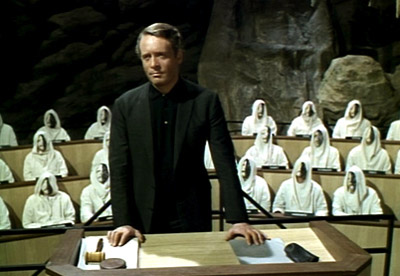
There is still an ongoing debate over how many episodes the series was supposed to be. It is said that producer Sir Lew Grade wanted 26 episodes. The number normally associated with a British series (sessons) run and that CBS wanted 36 for the United States. Patrick McGoohan is supposed to have said that either amount would spread the story too thin.
The reason for the final amount of episodes only being 17 is also debatable. There are reviewers saying that McGoohan would only agree to make 17 episodes, but others claim the series was cancelled forcing the program into that odd number. Either way the result is what some describe as a mixture of spy thriller, science fiction and allegory with a psychological theme. As I said an acid trip without the LSD/

Another debate is over who actually came up with the story idea Patrick McGoohan, or George Markstein. Whichever are the real answers to the three debates. The result is one great ride that heaven help any viewer who did not see the first couple of shows and came in with the story in progress.

The setting of the show is a place called "The Village".
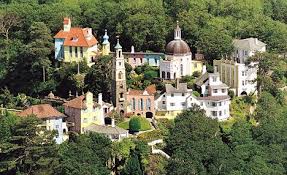
The location of "The Village" is deliberately confusing. At times it is referred too as being on an Atlantic Island, somewhere on the coast of Morocco, in Southern Portugal, or on the Baltic Sea among other locations. In the final episode it is revealed to actually be located within the United Kingdom and residents, not "Prisoners" have been driving to London on day trips.
Under "The Village" is a network of tunnels and caverns connecting some of the buildings and secret facilities. Along with providing "Support Services" such as plumping, waste disposal and cameras to spy upon all "The Prisoners" within.
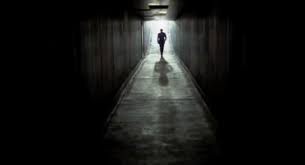
The story of "The Prisoner" starts at his London flat where this unnamed person is knocked out by gas and awakes in a duplicate of his apartment within "The Village". The man finds he is now referred too only as "Number Six" and this starts his journey to find out who is controlling everyone, is never seen and is only known as "Number One".
"Number Six" is watched over by the ever changing "Number Two". The website "Ferdy on Films" describes perfectly the first episode, which premiered on September 20, 1967, the underlining plot and the mysterious "Number Two".
During the 17 episodes of "The Prisoner" there were 16 actors in the role seen on screen and one actor providing the voice of an unseen "Number Two".
Then there were those "Dancing" (?) balls that roamed "The Village".called "The Rovers". What should have been very silly, becomes frightening as they control the movements of "The Prisoner" and others.

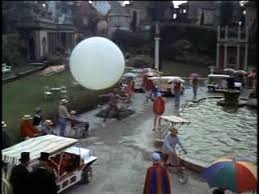
Within this hallucinatory story there was an underlining theme from Patrick McGoohan and George Markstein not lost on the British and American audiences.

"Number Six" represents "Individualism". Which is defined as
Take away all of the surrealist aspects of the series and it comes down to "Individuals" versus the "Group Mentality". Number Six's individualism soon creates a small, but strong group of rebels fighting the dictates of the current leaders.
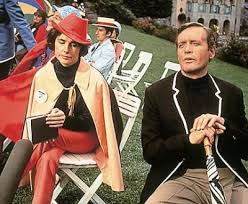
Then there was that final episode, called "Fall Out", that caused confused viewers in the United Kingdom to actually go to Patrick McGoohan's home seeking answers from the actor who wrote it. As a result for a period of time McGoohan actually went into hiding.
So let's cut to the chase and who was Number 1?
In 1984 Sir Lew Grade was interviewed for the documentary "Six Into One: The Prisoner File". He said that at the time of the final episode Patrick McGoohan still had not come up with an ending to the series. This ads credence to the possibility that it had been cancelled and the actor/writer/director had to come up with something quickly, or just leave the show unfinished.
In "Fall Out" Number Six is taken to a group of delegates all wearing hooded robes and masks being presided over by a man called "The President", below, as to the delegates see the first picture I posted on the series.
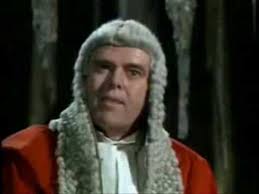
The President announces that Number Six has passed the "Ultimate Test" and now has the "Right to be an Individual". In short "Individualism has won out over the Group Mentality". A clue to what is going to happen next comes from the President who states:

Now comes the real "Trippy" confusion for viewers of the show.
Number Six first removes the mask of the delegates from Number One's face.

Under that mask in another of a Gorilla. "The Prisoner" now removes that mask.

To reveal his own face. Number Six is Number One.

An explanation, maybe, came in March 1977 from Patrick McGoohan in an interview for "TV Ontario", Canada:
https://www.quora.com/Can-anyone-explain-the-final-episode-of-The-Prisoner
The best way to describe Patrick McGoohan's co-created series "The Prisoner" is an Acid Trip without the LSD.

There is still an ongoing debate over how many episodes the series was supposed to be. It is said that producer Sir Lew Grade wanted 26 episodes. The number normally associated with a British series (sessons) run and that CBS wanted 36 for the United States. Patrick McGoohan is supposed to have said that either amount would spread the story too thin.
The reason for the final amount of episodes only being 17 is also debatable. There are reviewers saying that McGoohan would only agree to make 17 episodes, but others claim the series was cancelled forcing the program into that odd number. Either way the result is what some describe as a mixture of spy thriller, science fiction and allegory with a psychological theme. As I said an acid trip without the LSD/
Another debate is over who actually came up with the story idea Patrick McGoohan, or George Markstein. Whichever are the real answers to the three debates. The result is one great ride that heaven help any viewer who did not see the first couple of shows and came in with the story in progress.
The setting of the show is a place called "The Village".
The location of "The Village" is deliberately confusing. At times it is referred too as being on an Atlantic Island, somewhere on the coast of Morocco, in Southern Portugal, or on the Baltic Sea among other locations. In the final episode it is revealed to actually be located within the United Kingdom and residents, not "Prisoners" have been driving to London on day trips.
Under "The Village" is a network of tunnels and caverns connecting some of the buildings and secret facilities. Along with providing "Support Services" such as plumping, waste disposal and cameras to spy upon all "The Prisoners" within.
The story of "The Prisoner" starts at his London flat where this unnamed person is knocked out by gas and awakes in a duplicate of his apartment within "The Village". The man finds he is now referred too only as "Number Six" and this starts his journey to find out who is controlling everyone, is never seen and is only known as "Number One".
"Number Six" is watched over by the ever changing "Number Two". The website "Ferdy on Films" describes perfectly the first episode, which premiered on September 20, 1967, the underlining plot and the mysterious "Number Two".
The first episode, ‘Arrival,’ establishes most of the essentials with clarity and a surprisingly cinematic style, with the rapid, choppy editing and forceful, almost abstracting camerawork offering an expressive intensity TV still doesn’t offer much. The debut was put together by Don Chaffey, who had directed Jason and the Argonauts (1963) for Ray Harryhausen and worked on several Hammer films. The filmic, pop-art-infused look and structure of the series is just one of its stand-out qualities, and though some episodes dip close to the look and plotting of more average action series like The Saint, The Avengers, and Danger Man itself, that’s more the exception than the rule. The bewildering clash of textures that is The Village—the faux-Italianate architecture of the town centre, the seaside pleasantness of the neighbouring port with its mocking fake boat, and ultra-futuristic hidden abodes of the Guardians—establishes the matryoshka-like multiplicity of hidden truths. A serious question for Number Six is whose “side” runs The Village. Although clearly still conceived in the schismatic structures of the Cold War, the “sides” are kept purposefully vague, and soon enough, the notion that there are or soon will be no sides, that The Village is the future world in miniature, is introduced with relish by one of the Number Twos. A distinct pleasure of the show, over and above its Byzantine complications, is the impressive array of then-contemporary British acting talent, with the likes of Eric Portman, Leo McKern, Derren Nesbitt, George Baker, Guy Doleman, and Mary Morris popping up throughout, particularly in the Number Two spot.http://www.ferdyonfilms.com/2010/the-prisoner-tv-1967-1968/5277/
During the 17 episodes of "The Prisoner" there were 16 actors in the role seen on screen and one actor providing the voice of an unseen "Number Two".
Then there were those "Dancing" (?) balls that roamed "The Village".called "The Rovers". What should have been very silly, becomes frightening as they control the movements of "The Prisoner" and others.
Within this hallucinatory story there was an underlining theme from Patrick McGoohan and George Markstein not lost on the British and American audiences.
"Number Six" represents "Individualism". Which is defined as
The moral stance. political philosophy, ideology, or social outlook that emphases the moral worth of the individual.While the ever appearance changing "Number Two" represented "Collectivism", or "The Village" defined as:
The moral stance, political philosophy, ideology, or social outlook that emphases the group and it's interests.
Take away all of the surrealist aspects of the series and it comes down to "Individuals" versus the "Group Mentality". Number Six's individualism soon creates a small, but strong group of rebels fighting the dictates of the current leaders.
Then there was that final episode, called "Fall Out", that caused confused viewers in the United Kingdom to actually go to Patrick McGoohan's home seeking answers from the actor who wrote it. As a result for a period of time McGoohan actually went into hiding.
So let's cut to the chase and who was Number 1?
In 1984 Sir Lew Grade was interviewed for the documentary "Six Into One: The Prisoner File". He said that at the time of the final episode Patrick McGoohan still had not come up with an ending to the series. This ads credence to the possibility that it had been cancelled and the actor/writer/director had to come up with something quickly, or just leave the show unfinished.
In "Fall Out" Number Six is taken to a group of delegates all wearing hooded robes and masks being presided over by a man called "The President", below, as to the delegates see the first picture I posted on the series.
The President announces that Number Six has passed the "Ultimate Test" and now has the "Right to be an Individual". In short "Individualism has won out over the Group Mentality". A clue to what is going to happen next comes from the President who states:
All that remains is recognition of a man – a man of steel – a man magnificently equipped to lead us.Number Six makes a request to be taken to Number One and is escorted to an area where the most powerful person in "The Village" is watching him on a television monitor.
Now comes the real "Trippy" confusion for viewers of the show.
Number Six first removes the mask of the delegates from Number One's face.
Under that mask in another of a Gorilla. "The Prisoner" now removes that mask.
To reveal his own face. Number Six is Number One.
An explanation, maybe, came in March 1977 from Patrick McGoohan in an interview for "TV Ontario", Canada:
Number One was depicted as an evil, governing force in this Village. So, who is this Number One? We just see the Number Two's, the sidekicks. Now this overriding, evil force is at its most powerful within ourselves and we have constantly to fight it, I think, and that is why I made Number One an image of Number Six. His other half, his alter ego.Most viewers even today do not buy it. There are books upon books on this 17 part series and fan pages devoted to just explaining the final episode. Here is a link to one by Joseph Dickerson:
https://www.quora.com/Can-anyone-explain-the-final-episode-of-The-Prisoner
"DANGER MAN" MEETS "THE PRISONER"In an interview with James Follett in 1994 co-creator George Markstein stated that he and Patrick McGoohan had tossed around the idea of making "Number Six's" identity turn out to be "Danger Man" John Drake.
Apparently at some time in the past Drake had proposed to his superiors a plan to deal with retired agents now posing a possible security risk. His idea was to have retired agents go to a comfortable "Retirement Home" at the agency's expense. There they would live out the rest of their lives under unobtrusive surveillance, but in pleasant surroundings.
Many years pass and John Drake discovers his idea was stolen and "The Village" has been created, but not as a retirement home for agents. It is now a means of interrogation within a guarded prison for these agents. Drake fakes his own retirement and enters "The Village" in the hope of finding out whose behind it. However, with all the nationalities around him he now not sure whose "Village" this is and he needs to find out and escape.
Markstein later stated:
George Markstein's comment would seem to suggest that the series was cut short for some yet verified unexplained reason and Patrick McGoohan had to come up with a quick ending, or as I said leave the viewers hanging.
A FEW COMMENTS
Prior to finishing the filming of "The Prisoner". Patrick McGoohan made an American film with Rock Hudson directed by John Sturges based upon Alistair McLean's "Ice Station Zebra". McGoohan's nondescript cover name was "Mr. Jones" a "Secret Agent" working for MI-6. Type casting? I still enjoy the movie that producer/director/music and screenplay writer John Carpenter described as:
Patrick McGoohan did not always play a secret agent and like "The Scarecrow of Romney Marsh" was seen in costume dramas such as 1971's "Mary, Queen of Scots", 1977's made for television movie "The Man in the Iron Mask" and 1995's "Braveheart". He is an understated evil Warden in Clint Eastwood 1979's "Escape from Alcatraz" and in one of my favorite comic book movies 1996's "The Phantom". McGoohan is the father of "Kit" Walker who makes one mistake and appears to "Kitt" as a father figure ghost.
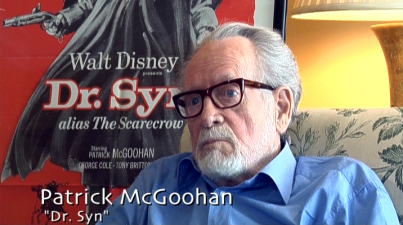
The actor passed away in Santa Monica, California on January 13, 2009. Patrick McGoohan was 80 years old.
Apparently at some time in the past Drake had proposed to his superiors a plan to deal with retired agents now posing a possible security risk. His idea was to have retired agents go to a comfortable "Retirement Home" at the agency's expense. There they would live out the rest of their lives under unobtrusive surveillance, but in pleasant surroundings.
Many years pass and John Drake discovers his idea was stolen and "The Village" has been created, but not as a retirement home for agents. It is now a means of interrogation within a guarded prison for these agents. Drake fakes his own retirement and enters "The Village" in the hope of finding out whose behind it. However, with all the nationalities around him he now not sure whose "Village" this is and he needs to find out and escape.
Markstein later stated:
The prisoner was going to leave the Village and he was going to have adventures in many parts of the world, but ultimately he would always be a prisoner. By that I don't mean he would always go back to the Village. He would always be a prisoner of his circumstances, his situation, his secret, his background ... and 'they' would always be there to ensure that his captivity continues
George Markstein's comment would seem to suggest that the series was cut short for some yet verified unexplained reason and Patrick McGoohan had to come up with a quick ending, or as I said leave the viewers hanging.
A FEW COMMENTS
Prior to finishing the filming of "The Prisoner". Patrick McGoohan made an American film with Rock Hudson directed by John Sturges based upon Alistair McLean's "Ice Station Zebra". McGoohan's nondescript cover name was "Mr. Jones" a "Secret Agent" working for MI-6. Type casting? I still enjoy the movie that producer/director/music and screenplay writer John Carpenter described as:
Why do I love this movie so much?Calling it a guilty pleasure in an article for Turner Classic Movies. I would agree that even with the dated special effects especially the obvious model aircraft. The interplay between McGoohan and Hudson is fun to watch and I think he was poking fun at his own image at times.
Patrick McGoohan did not always play a secret agent and like "The Scarecrow of Romney Marsh" was seen in costume dramas such as 1971's "Mary, Queen of Scots", 1977's made for television movie "The Man in the Iron Mask" and 1995's "Braveheart". He is an understated evil Warden in Clint Eastwood 1979's "Escape from Alcatraz" and in one of my favorite comic book movies 1996's "The Phantom". McGoohan is the father of "Kit" Walker who makes one mistake and appears to "Kitt" as a father figure ghost.
The actor passed away in Santa Monica, California on January 13, 2009. Patrick McGoohan was 80 years old.




No comments:
Post a Comment